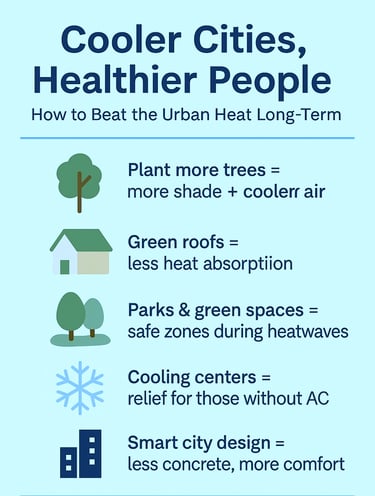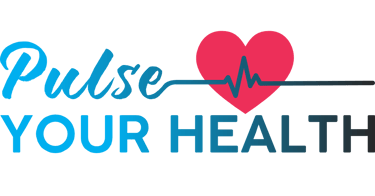Stay updated on what is trending in health. Discover tips and resources for a healthier, balanced life.
Excessive Heat and Your Health: Why City Living Feels Hotter — and More Dangerous
Excessive heat can pose serious health risks, especially in cities. Learn who’s most at risk, how to stay safe in high temperatures, signs of heat illness, and long-term solutions like planting trees and urban cooling strategies.
WELLNESS
Dr. S. Ali
7/8/20256 min read


Have you ever noticed how stepping outside in the middle of summer feels like walking into an oven—especially in the city? That’s not just your imagination. Excessive heat is a growing issue in many urban areas, and rising temperatures are doing more than just making us sweat. They're putting our health at serious risk.
Let’s break down how this type of weather impacts people—especially those living in cities—and what we can do to protect ourselves.
What Is “Excessive Heat”?
Excessive heat refers to a prolonged period of very hot weather—often with high humidity—that’s significantly above the usual temperature range for a given area. It can lead to heatwaves, which have become more frequent due to climate change.
When daytime temperatures climb above 35–40°C (95–104°F) and nighttime temperatures don't drop enough to offer relief, the body starts to struggle. Even healthy individuals can experience heat-related health problems when exposed for too long.
Why Cities Get So Hot: The Urban Heat Island Effect
City environments are often much hotter than surrounding rural areas. This is due to a phenomenon called the urban heat island effect, which happens when natural landscapes are replaced with:
Asphalt roads
Concrete buildings
Dark rooftops
Limited greenery
These materials absorb heat during the day and release it slowly at night, keeping the temperature high around the clock. Cities also have more vehicles, air conditioning units, and machinery—all of which generate additional heat.
This means urban areas can be several degrees hotter than nearby towns or countryside, making hot weather even more dangerous for city residents.
How High Temperatures Affect Your Health
Excessive heat can have real consequences for your body. Here's how it affects you:
1. Dehydration
When you sweat, you lose water and electrolytes. Without enough fluids, you may feel dizzy, tired, or confused. Left unchecked, dehydration can affect your kidneys, blood pressure, and mental clarity.
2. Heat Cramps
These are painful muscle spasms caused by loss of salts and fluids during intense sweating. They often occur in your arms, legs, or abdomen.
3. Heat Exhaustion
This is a serious warning sign. Symptoms include:
Nausea
Weakness
Headache
Fainting
Pale, clammy skin
If not treated, it can progress to heat stroke.
4. Heat Stroke
This is the most dangerous heat-related illness and a medical emergency. The body temperature rises rapidly, and the body can no longer cool itself. It may lead to confusion, unconsciousness, and even death if not treated immediately.
5. Exacerbation of Chronic Conditions
People with diabetes, heart disease, asthma, or high blood pressure often find their conditions worsen during extreme heat. Even medications for these conditions can increase heat sensitivity. The WHO explains that heat extremes can worsen existing health conditions and lead to serious illnesses such as heat stroke.
Who Is Most at Risk?
While anyone can feel the effects of extreme heat, some groups are more likely to develop serious health problems because of how their bodies respond—or struggle to respond—to high temperatures.
Elderly Individuals (65+)
As we age, our body’s ability to regulate temperature becomes less efficient. Older adults often:
Sweat less (which reduces natural cooling)
Have chronic health conditions like heart disease or diabetes
Take medications (like diuretics or blood pressure meds) that affect hydration or heat tolerance
May live alone and delay seeking help when symptoms start
These factors combine to increase the risk of heat exhaustion or heat stroke, even in otherwise healthy seniors.
Children, Especially Infants
Young children, especially babies, are not as good at regulating their body temperature. Their bodies:
Heat up faster than adults’
Sweat less
Depend entirely on adults to keep them cool and hydrated
Plus, they may not recognize or be able to communicate symptoms like dizziness, thirst, or discomfort—so the danger can go unnoticed until it’s serious.
Pregnant Women
Pregnancy already raises a woman’s core body temperature. During extreme heat:
It becomes harder for the body to cool down
Dehydration can happen more quickly
Heat stress may increase the risk of complications like preterm labor or fainting
Staying cool and well-hydrated is especially important during pregnancy.
People with Chronic Illnesses
Conditions like diabetes, heart disease, asthma, or kidney disease make it harder for the body to handle stress—including heat stress. For example:
Diabetes can impair sweating and thirst response
Heart conditions strain the circulatory system, which already works harder in hot weather
Some medications for these conditions also increase sensitivity to heat or cause dehydration
Heatwaves can quickly escalate into emergencies for those with ongoing health issues.
Outdoor Workers
People who work outside—construction workers, delivery drivers, farmers—are exposed to high temperatures for long hours, often with limited access to shade or hydration. Physical activity also raises body temperature, putting them at greater risk of heat-related illnesses.
Even if they’re young and healthy, the constant exposure makes outdoor workers especially vulnerable.
Homeless or Low-Income Individuals
Those without reliable housing or air conditioning have fewer options to escape the heat. They may:
Sleep or live in poorly ventilated spaces
Lack access to water, shade, or cooling centers
Delay seeking medical help due to cost or transportation barriers
This group often experiences the harshest impact during heatwaves—and unfortunately, many go unnoticed.
What You Can Do: Smart Tips for Hot Weather Safety
Here are practical steps to protect yourself and others during hot spells:
Stay Hydrated
Drink plenty of water, even if you’re not thirsty. Avoid alcohol and caffeine as they can lead to further dehydration.
Dress Smart
Wear lightweight, light-colored, and loose-fitting clothing. Hats and sunglasses can offer added protection from the sun.
Avoid Peak Heat Hours
Try to stay indoors between 10 AM and 4 PM, when temperatures are usually the highest. If you need to be outside, take frequent breaks in the shade.
Cool Your Space
Use fans, air conditioners, or take cool showers. If you don’t have AC, visit malls, libraries, or community cooling centers.
Check on Others
Elderly neighbors, young children, and anyone living alone may need extra care during a heatwave. A quick call or visit could save a life.
What Can Cities Do?
While staying hydrated and avoiding peak sun hours can protect you today, long-term planning is essential for creating cooler, healthier cities. Here are some bigger-picture strategies communities can adopt:
Plant More Trees
Trees aren’t just pretty—they’re powerful! They provide shade, reduce surface temperatures, and cool the air through a process called transpiration. Streets and parks with trees can be several degrees cooler than those without.
Use Cool or Green Roofs
Painting rooftops with reflective materials or covering them with vegetation (green roofs) helps prevent buildings from absorbing and trapping heat. This lowers indoor temperatures and reduces the demand for air conditioning.
Design Greener Urban Spaces
Adding parks, green belts, and vertical gardens to cities not only improves air quality but also reduces the heat trapped by asphalt and concrete. These green spaces offer shady, cooler areas for people to rest and recover during hot days.
Create More Cooling Centers
Communities can set up designated indoor spaces—like libraries, malls, or community centers—where people without access to air conditioning can go during heatwaves.
Rethink Urban Planning
Using lighter-colored paving materials, widening shaded sidewalks, and reducing heat-trapping surfaces can all help cities stay cooler during hot weather.
These long-term strategies won’t bring instant relief during a heatwave, but they can make cities more resilient—and safer—for the years ahead.
Heat Illness: When to Seek Help
Heat-related illnesses can become serious — even life-threatening — if not treated promptly. It’s important to recognize the warning signs and act quickly.
Call emergency services right away if someone shows any of the following symptoms:
A body temperature above 40°C (104°F) – This is a sign of heatstroke and needs immediate medical attention. If someone shows symptoms like confusion, lack of sweating, or a body temperature above 40 °C (104 °F), you should call emergency services at once.
Confusion, disorientation, or unresponsiveness – These symptoms can indicate the brain is being affected by the heat.
A rapid or pounding heartbeat – This may signal that the body is under severe stress trying to cool down.
Hot, dry skin with no sweating – Contrary to popular belief, not sweating during extreme heat is a dangerous sign, especially during exertion.
Seizures or fainting – These are signs of a medical emergency and should never be ignored.
What to do while waiting for help:
Move the person into a shaded or air-conditioned area.
Remove excess clothing to help the body cool down.
Apply cool, wet cloths to the skin or spray water on them.
Use fans, if available, to help with evaporation.
If they’re conscious, offer small sips of cool (not ice-cold) water — but never force fluids.
Getting professional help fast can make all the difference. Heatstroke is a medical emergency, and quick action saves lives.
Final Thoughts
We often think of heat as just a seasonal inconvenience—but in cities, excessive heat and high temperatures are a real health threat. With climate change making heatwaves more intense and frequent, it’s important to recognize the signs, protect yourself, and support vulnerable people in your community.
Taking a few smart steps can help you stay safe, even when the temperature is off the charts.
Sources:
CDC – Heat-Related Illnesses
https://www.cdc.gov/niosh/heat-stress/about/illnesses.html
WHO –Heat and Health
https://www.who.int/news-room/fact-sheets/detail/climate-change-heat-and-health
NOAA / National Weather Service -- Heat Cramps, Exhaustion, Stroke
https://www.weather.gov/safety/heat-illness
Mayo Clinic -- Heat Exhaustion: First Aid
https://www.mayoclinic.org/first-aid/first-aid-heat-exhaustion/basics/art-20056651
Ready.gov -- Extreme Heat
https://www.ready.gov/heat
Pulse Your Health
Empowering you to achieve your health goals.
Contact
© 2025. All rights reserved.
Disclaimer: The content on this website is for informational purposes only and is not medical advice. Always seek the advice of your physician or other suitably qualified healthcare professional for diagnosis, treatment and your health related needs.
